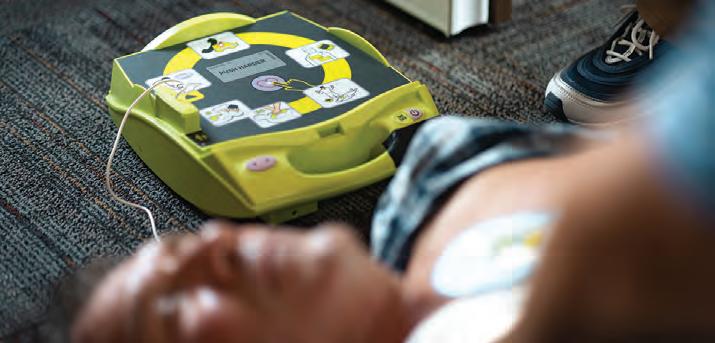
3 minute read
Do You Know Where the AED Is?
SIMPLE STEPS TO KEEP SAFETY TOP-OF-MIND FOR YOUR TEAM
BY THERESA YOUNG
I will never forget the night three years ago when I woke to the sound of screams from my neighbors as they watched their home burn in a devastating fire. I could feel the heat from the fire on my face as I opened my front door, crossed the street, and called 911.
Multiple generations lived in that Newark home, and thanks to smoke alarms, they were all able to get out in time. And thanks to my Red Cross training, I was able to respond and help in the way it was needed. I feel gratitude every day for those two things.
Emergencies happen every day, both at home and at work, and being prepared — including maintaining and testing smoke alarms — can make the difference between safety and tragedy.
When was the last time you reminded employees where to meet after evacuating the office during an emergency? Do you have an automated external defibrillator (AED) in your office, and does everyone know where it is? Do they know what to do if a colleague went into cardiac arrest, or showed signs of a stroke, or anaphylaxis?
Emergency preparedness is critically important and doesn’t have to be a huge, time-consuming task. Consider opening your next staff meeting with a trivia question about where the AED is, scheduling a CPR or first aid class for your team-building day, or reaching out to your local Red Cross office to learn how to be Red Cross Ready.
Make sure safety information is also included in your onboarding process for new employees. It doesn’t help to have an evacuation plan if it isn’t shared with new colleagues.
At the Red Cross, we begin every staff meeting or large gathering by noting where the restrooms and emergency exits are. Small actions add up and help keep safety top of mind for the whole team.
As I saw firsthand with my neighbors, every second counts during a fire. On average, you have two minutes or less to get out safely. Having a well-practiced evacuation plan is key. It’s the same for cardiac arrest and other medical emergencies. Having the training to stay calm and administer CPR, use an AED, or an EpiPen makes all the difference in those first critical minutes before first responders arrive.
Safety education is at the core of the Red Cross mission — dating back to when our founder, Clara Barton, taught first aid classes out of her home. Last year, the American Red Cross trained more than 10,000 people in first aid, CPR, AED, water safety, and other lifesaving skills in Delmarva.
The best part? Every one of your employees and colleagues who learns these essential skills in the workplace carries them home, making their families safer. When we keep safety top of mind, we all benefit.
Theresa Young is the executive director of American Red Cross of Delmarva.










